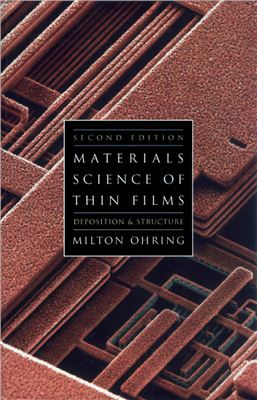2nd Edition. Academic Press, 2002. 808 p.
There have been at least 200 books written on various aspects of thin film science and technology, but this is the first true textbook, specifically intended for classroom use in universities. In my opinion there has been a crying need for a real textbook for a long time. Most thin film courses in universities have had to use many books written for relatively experienced thin film scientists and engineers, often supplemented by notes prepared by the course instructor. The Materials Science of Thin Films, a true textbook, complete with problems after each chapter, is available to serve as a nucleus for first courses in thin film science and technology.
In addition to his many years of experience teaching and advising graduate students at Stevens Institute of Technology, Professor Ohring has been the coordinator of an on-premises, M.S. degree program offered by Stevens at the AT&T Bell Laboratories in Murray Hill and Whippany, New Jersey. This ongoing cooperative program has produced over sixty M.S. graduates to date. Several of these graduates have gone on to acquire Ph.D. degrees. The combination of teaching, research, and industrial involvement has provided Professor Ohring with a broad perspective of thin film science and technology and tremendous insight into the needs of students entering this exciting field. His insight and experience are quite evident in this textbook.
Foreword to First Edition.
Preface.
Acknowledgments.
A Historical Perspective.
A Review of Materials Science.
Vacuum Science and Technology.
Thin-Film Evaporation Processes.
Discharges, Plasmas, and Ion-Surface Interactions.
Plasma and Ion Beam Processing of Thin Films.
Chemical Vapor Deposition.
Substrate Surfaces and Thin-Film Nucleation.
Epitaxy.
Film Structure.
Characterization of Thin Films and Surfaces.
Interdiffusion, Reactions, and Transformations in Thin Films.
Mechanical Properties of Thin Films.
Index
There have been at least 200 books written on various aspects of thin film science and technology, but this is the first true textbook, specifically intended for classroom use in universities. In my opinion there has been a crying need for a real textbook for a long time. Most thin film courses in universities have had to use many books written for relatively experienced thin film scientists and engineers, often supplemented by notes prepared by the course instructor. The Materials Science of Thin Films, a true textbook, complete with problems after each chapter, is available to serve as a nucleus for first courses in thin film science and technology.
In addition to his many years of experience teaching and advising graduate students at Stevens Institute of Technology, Professor Ohring has been the coordinator of an on-premises, M.S. degree program offered by Stevens at the AT&T Bell Laboratories in Murray Hill and Whippany, New Jersey. This ongoing cooperative program has produced over sixty M.S. graduates to date. Several of these graduates have gone on to acquire Ph.D. degrees. The combination of teaching, research, and industrial involvement has provided Professor Ohring with a broad perspective of thin film science and technology and tremendous insight into the needs of students entering this exciting field. His insight and experience are quite evident in this textbook.
Foreword to First Edition.
Preface.
Acknowledgments.
A Historical Perspective.
A Review of Materials Science.
Vacuum Science and Technology.
Thin-Film Evaporation Processes.
Discharges, Plasmas, and Ion-Surface Interactions.
Plasma and Ion Beam Processing of Thin Films.
Chemical Vapor Deposition.
Substrate Surfaces and Thin-Film Nucleation.
Epitaxy.
Film Structure.
Characterization of Thin Films and Surfaces.
Interdiffusion, Reactions, and Transformations in Thin Films.
Mechanical Properties of Thin Films.
Index

